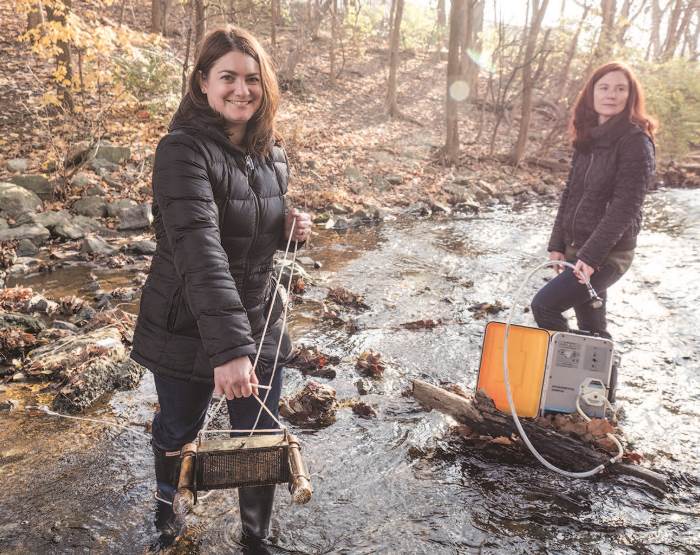A $5 fix for a nasty parasite

Kristen Jellison and Sabrina Jedlicka have a grant from NSF to develop a biomimetic surface that selectively attaches to Cryptosporidium oocysts.
The parasite Cryptosporidium has long baffled medical doctors and utility operators. When ingested, the microscopic protozoan causes gastrointestinal illness that has no medical cure and can be fatal to persons with weak immune systems. Crypto is so small that it can pass through the filters of water-treatment plants, and it is resistant to chlorine, the most common water disinfectant.
Crypto spreads through fecal-oral transmission. When an animal drinks tainted water, the pathogen travels through its host’s digestive system, is excreted into the environment and is carried by rain or runoff to a stream. The key to preventing Crypto from contaminating drinking water supplies, says Kristen Jellison, is to detect its source in watersheds and thus determine where limited utility budgets can most effectively be spent.
Jellison, an associate professor of civil and environmental engineering, has spent a decade studying Crypto in collaboration with the Philadelphia Water Department. With funding from an NSF CAREER Award, she has learned that the environmental form of Crypto, the oocyst, binds to biofilms on the surfaces of rocks and other inanimate objects in streams. These biofilms provide a protective haven for the pathogens.
The conventional method for detecting Crypto, says Jellison, is to remove and filter water from a suspected stream. But this “point in time” technique provides only a snapshot of stream conditions. Filters cost more than $100 apiece. Due to high costs and limited budgets, utilities are forced to limit the number of sample locations they monitor as well as the frequency of sample collections.
Jellison and Sabrina Jedlicka, an assistant professor of materials science and engineering, have a three-year grant from NSF to develop a biomimetic surface, or a substrate that selectively attaches to Crypto oocysts. Roughly the size of a laboratory slide, the substrate will be physically and chemically engineered to bind only with oocysts and to remain in a stream as long as two weeks.
“Our goal,” says Jedlicka, “is to make a substrate based on the shape or surface chemistry of the Crypto oocysts so they attach to the substrate in a robust and predictable manner. This will enable us to quantify the number of oocysts passing across the surfaces over a period of time in a specific location.”
“We think we can develop a surface that can be commercially produced for around $5,” says Jellison. “This would allow utilities and water resource managers to better protect the public from exposure by sampling more locations with greater frequency and obtaining more reliable and comprehensive data about the sources of the parasite in the watershed.”
The two researchers and their students have identified the chemistry and mechanics that cause oocysts to bind to biofilms, and they have modeled the kinetics of the binding. Now they want to design a biomimetic surface such that oocysts bind consistently to the substrate regardless of water quality, time of year, amount of sunlight, presence of nutrients in the water, water temperature, velocity and flow rate of the water, and other conditions.
Ultimately, their device could be used to determine the concentration of oocysts, and their points of entry, in complex watersheds with multiple potential point sources.
“We need to monitor upstream and downstream of sewage discharge pipes, agricultural fields, recreational sites and wildlife gathering areas,” says Jellison. “These are places where oocysts are likely to enter a watershed. This kind of information would help utilities focus their efforts strategically within large complex watersheds to have the biggest impact on the protection of public health.”
Story by Kurt Pfitzer
Posted on:

